On November 21st I went to see the play Hamilton at the Altria Theater. This play was about the timeline of Hamilton’s life from the time he worked under President George Washington to the time he was in a standoff with Alexander Burr. Hamilton began as an immigrant who wasn’t very wealthy, simply looking for a chance to show his talent. Eventually, once Washington discovered his talent, he was employed as a writer for the American Revolution. However, he wanted to be on the field at war with the soldiers. It angered Hamilton further when the leader that Washington put at the front line was incompetent. Eventually, Hamilton was given his opportunity or his “shot” as he kept saying in the play but soon realized 1) he was better with writing and 2) his family was suffering with him never being at home. A major part of his life that was emphasized was his writing of the Federalist papers. The play noted that although he worked with John Adams and James Madison he ended up writing most of the papers because that is how strongly he believed in creating a foundation for the new country that was free. Apart from his role in the politics and forming of America, the play went into Hamilton’s family life and discussed his love interests in Angelica and Eliza, the Schuyler sisters. In addition, the play also went into his love affair with another woman while he was working abroad–exposing each part of his life even down to his flaws.
The part I enjoyed the most about the play was the ending when the focus shifted slightly from Hamilton to Burr. After the stand-off where Hamilton and Burr both stood in the circle and Burr shot Hamilton, the narration described that because of this moment Burr is seen as the villain in history. All of his accomplishments and the work that he did for the country were overshadowed by this one moment which he admitted himself was juvenile of him but at the time he could not see that. All he saw was an opportunity to get rid of his opponent which he took advantage of. I appreciated and liked the fact that this was included in the play because it showed a part of history that isn’t often discussed– instead of simply referring to Burr as Hamilton’s killer we were able to get an inside view on what actually happened to Burr after the shooting (he was hated by everyone) and that he himself regretted the action but knew no better.
Leave a Comment

